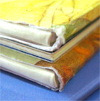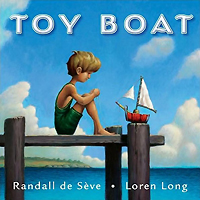|
|
|
|
|
|
|

| 최근 이 책을 구매하신 다른 회원의 책장 |
|
 |
|
|
|
[ 책 소개 ]
* New York Times Bestseller
* Publishers Weekly Cuffie Award for Favorite Picture Book of the Year 수상도서
* Great Lakes Book Award for Children's Picture Book 수상도서
소년은 깡통, 코르크마개, 연필, 하연 천등을 이용해서 자신이 직접 만든 장난감 배를 너무나도 좋아합니다. 목욕할 때나 잠잘 때도 소년은 장난감 배를 항상 옆에 뒀습니다.그리고 바다같이 넓은 호수에 가서 한쪽 끝을 실로 묶은 다음, 장난감 배를 호수 위에 띄워 보내곤 했습니다.
어느날 호수에서 장난감 배를 갖고 놀다가 엄마 손에 이끌러 집으로 가는 바람에 장난감 배에 묶여져 있는 실을 놓치고 말았습니다. 소년의 외침을 뒤로 하고, 장난감 배는 파도를 타고 넓은 호수의 먼곳으로 떠내려갔습니다. 사실은 장난감 배는 끈에 묶여 있는 것 대신에 큰 배들 같이 자유롭게 먼 곳으로 여행을 다니고 싶어했었습니다.
호수에서 장난감 배는 견인선, 페리선, 스피드보트, 경주용 요트들을 만났습니다만, 그 때마다 배들은 장난감 보트에게 비키라고 큰 소리를 치네요. 큰 배들이 지나가면서 일으키는 거센 물살에 이리저리 치이고, 배 안에는 물이 가득 차서 거의 침몰되기 일보직전이 되었습니다.
그러다가 낡은 고깃배를 만나게 되고, 고깃배의 도움으로 방향을 바꾸자 장난감 배의 돛이 바람을 잔뜩 받게 되어서 빠른 속도로 호숫가로 갈 수 있게 되었습니다. 그리고 호숫가에는 소년이 장난감배를 발견하고는 손을 흔들어 줍니다...
튼튼한
| 닫기x |  What is 하드커버? What is 하드커버?
양장본이라고도 불리우며, 표지가 단단한 판지로 만들어진 책입니다.
판지를 천이나 가죽으로 감싸기도 합니다. 책의 속지는 일반적으로 중성처리된 종이(Acid-free paper)를 사용해서 잘 변질이 되지 않기 때문에 오랫동안 보관하기에 적합합니다. 이 종류의 책은 더스트 재킷, 또는 더스트 커버로 불리는 표지덮개가 함께 있는 경우가 많습니다. 간혹 내부 속지가 콩기름 코팅이 된 경우 고약한 냄새가 나는 책도 있습니다.
|
[ 관련 동영상 보기 ]
 ▶
[ 서지 정보 ]
Hardcover: 40 pages
ISBN-10: 0399243747
ISBN-13: 978-0399243745
책 크기: 24.7 cm x 24.7 cm
[ 영문 서평 ]
Book Description
A little boy has a toy boat that he made out of a can, a cork, a yellow pencil, and some white cloth. The boy and his boat are inseparable . . . until the day the wind pushes the boat out into the wide lake, and the little boat must face fierce waves, a grumpy ferry, a sassy schooner, and a growling speed boat if he is to find his way home. From Randall de Seve and bestselling artist Loren Long, creator of the Otis series and illustrator of The Little Engine That Could, comes a child-friendly adventure sure to inspire imaginative toy play.
Publishers Weekly
A boy's handmade toy boat plays the metaphorical role of a child longing for independence in de Seve's auspicious first picture book. The text begins in simple language that lightly implies a parent/child bond: "The boy loved the boat, and they were never apart. They bathed together. They slept together." Every day the boy sails the boat in the lake, holding onto it with a string. Usually the boat feels content, but occasionally the sight of big boats awakens its curiosity about "what it would feel like to sail free." A sudden change in the weather occasions the toy boat's premature adventure out of the boy's protective grasp, described in suspenseful text and acrylics that imaginatively extend de Seve's story. Long (the re-illustrated Little Engine that Could) shrewdly illustrates no persons other than David, even though David's mother plays a pivotal part. Rather, the toy boat has a face (readers should look carefully at the cork holding its mast) and, as it encounters the big boats at last, each wears its own visible personality. A giant ferry occupying most of a spread bears down on the toy boat, its windows, decks and trimmings shaped into an enraged visage, complete with glaring eyes and pursed lips; the toy boat shrinks dramatically in the wake of a huge speedboat depicted as a flame-colored shark. Not until the reassuring conclusion can the toy boat again be seen from the boy's perspective. A resonant tale with wide appeal.
School Library Journal
A boy loves his toy boat and he takes it everywhere, keeping it close on a string near open water. When he drops the string and the toy is carried far out on the lake, it faces the perils of high waves, stormy skies, and large, mean-spirited vessels. The small boat, near sinking, sail heavy with water, misses the child terribly and floats aimlessly all night, lonely and frightened. (Even the moon is shown weeping at such a pathetic plight.) Finally the next day, "a humble little fishing boat" takes pity on the little boat since "it knew how it felt to be pushed around on the lake." It guides the toy toward shore - and for a few moments the little boat feels the joy of freedom, wind in its sail. Then the boy sees it and the boat is home again. Now, the boy occasionally lets the string go when they are by the lake since the boat knows to come back. This story of freedom and its perils has the potential to be unsettling for a young audience. The cruel eyes of the giant ferry bearing down on the small boat and the painted sharklike teeth on the side of the speedboat with its "screaming" motor can easily be construed as menacing and can send a negative instead of heartening message. Only near the end, on the spread where the little boat is sailing, does the acrylic art show the pleasure of the open sky and freedom at the prow. This book has limited child appeal.
|
|
|
|
|
|
|
|
|